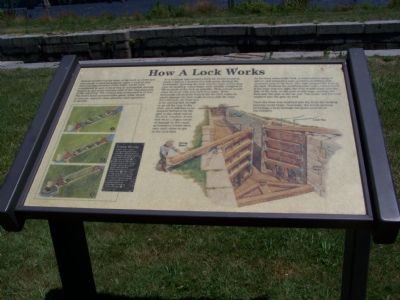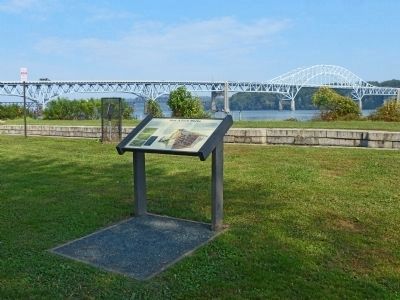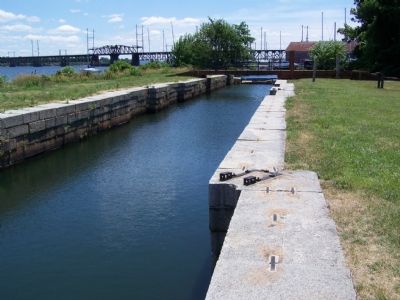Havre de Grace in Harford County, Maryland — The American Northeast (Mid-Atlantic)
How a Lock Works
Instead of following the slope of the land, as rivers and streams do, a canal periodically takes a vertical step between long stretches of flat water. Locks were constructed at each vertical step to accomplish moving barges up and down between each of the long stretches of flat waterway. The vertical step at this lock is 12 feet. The lock’s hand–operated mitre gates, while simple in concept, required close attention and experience to operate.
As a boatman approached a lock, he would sound an alarm a half to a quarter of a mile away, alerting the locktender. Entering the lock was the most demanding part of canalling. Canal boats were usually designed to fill as much of the lock as possible. Thus a boat would enter the lock with only inches to spare. If the helmsman allowed the boat to hit the lock walls, he could damage the lock walls or even sink the boat. Nevertheless, the boat had to be moving fast enough to go all the way in the lock, yet still had to be stopped before it hit the gate at the other end of the lock. Crashes of this sort were a major cause of damage to the canal, as boatmen would often race each other to get to the lock first.
As the boat entered the lock, a crewmember jumped ashore and wrapped a rope around a snubbing post anchored next to the lock. The rope stopped the boat in the lock. Working the snubbing post took a steady hand. If the rope was too tight, the boat would crash into the side of the lock, or the post would snap, sending the boat into the gate at the far end. Too loose, and the boat crashed into the gate as well.
Once the boat was snubbed into the lock, the locking process could begin. Generally, the whole process of locking a boat through the gates took about ten minutes.
[Sidebar:]
Locking Through
Upper sluice valves are opened and water in lock is raised to level of upstream canal. Upper gates are opened and boat enters lock ❶. Upper gates and their sluice valves are closed. Sluice valves in lower gates are opened, allowing water to empty from lock ❷. The boat is lowered slowly as the water in the lock drops to level of downstream canal. Lower gate is opened and boat proceeds on lower level of canal ❸.
Topics and series. This historical marker is listed in these topic lists: Industry & Commerce • Waterways & Vessels. In addition, it is included in the Susquehanna and Tidewater Canal series list.
Location. This marker has been replaced by another marker nearby. It was located near 39° 33.363′ N, 76° 5.597′ W. Marker was
in Havre de Grace, Maryland, in Harford County. Marker could be reached from Conesto Street, 0.2 miles Erie Street. Touch for map. Marker was in this post office area: Havre de Grace MD 21078, United States of America. Touch for directions.
Other nearby markers. At least 8 other markers are within walking distance of this location. How A Lock Works (a few steps from this marker); You Are Standing On A Pivot (Or Swing) Bridge (within shouting distance of this marker); The Susquehanna and Tidewater Canal (within shouting distance of this marker); The Lafayette Trail (within shouting distance of this marker); The Lock House (within shouting distance of this marker); This Wye Oak (within shouting distance of this marker); a different marker also named This Wye Oak (about 400 feet away, measured in a direct line); Under Attack (approx. ¼ mile away). Touch for a list and map of all markers in Havre de Grace.
Related marker. Click here for another marker that is related to this marker. This marker has been replaced with the linked marker, which has a slightly different inscription.
Credits. This page was last revised on November 23, 2022. It was originally submitted on July 1, 2007, by Bill Pfingsten of Bel Air, Maryland. This page has been viewed 1,756 times since then and 8 times this year. Last updated on January 18, 2021, by Bradley Owen of Morgantown, West Virginia. Photos: 1. submitted on July 1, 2007, by Bill Pfingsten of Bel Air, Maryland. 2. submitted on October 10, 2013, by Allen C. Browne of Silver Spring, Maryland. 3. submitted on July 1, 2007, by Bill Pfingsten of Bel Air, Maryland.


